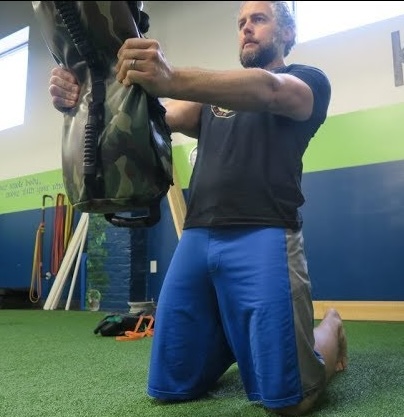The Great Grip Myth: Why Hanging From Bars Isn’t Your Fountain of Youth
2025-10-31
Jessica Bento, Physical Therapist (Creator of DVRT Restoration, DVRT Rx Shoulder, Knee, Pelvic Control, & Gait Courses)

Let’s be real: in fitness circles, grip strength has become the rockstar biomarker. “Want to live longer?” the internet says. Hold a dead hang for two minutes, 1.5 for women, 2 for men and supposedly, you’re set for longevity.
View this post on Instagram
Cue the montage of people awkwardly hanging from pull-up bars, arms shaking. But here’s the thing most of us are missing the point. Your grip itself isn’t what is REALLY important, so what is?
What the Research Actually Says (and Where It Gets Real)
It’s not wrong to say grip strength correlates with things that matter but it’s oversold as a magic pill.
A narrative review calls grip strength an “indispensable biomarker” in older adults, linking it cross-sectionally with overall strength, falls, cognition, nutrition, quality of life, and even mortality.
Meta-analyses show higher grip strength is associated with lower all-cause mortality in older populations.
But in a familial longevity study, people genetically “programmed” to live long didn’t consistently have stronger grip than controls once you adjusted for body composition and confounding variables.
Also, grip strength is increasingly proposed as a “vital sign” or screening tool but that doesn’t imply grip training is the priority. Most make a correlation causation fallacy ( in which two events occurring together are taken to have established a cause-and-effect relationship).
So yes grip strength is predictive in populations studied especially in geriatrics but that doesn’t mean hanging longer equals immortality.

The Missing Logic: Grip Isn’t the Cause, It’s a Marker
The classic error is to assume if grip is low, you must directly train grip to improve longevity.
That’s like blaming the thermometer for the fever. Grip strength shows something’s off; it doesn’t cause the problem
Grip strength tend to often reflects overall muscle health, neuromuscular integrity, and physical activity levels.
Someone with good grip is likely more active, has better muscle mass elsewhere, better nutrition, etc.
It’s not really that grip causes longevity, but rather that something else underlying (overall fitness, resistance training, movement consistency) is doing the heavy lifting.
In clinical settings, especially with older adults, grip is useful to flag frailty risk, nutritional risk, or functional decline not to become the main training target.
Why I Don’t Always Measure Grip (Even in Older Clients)
You might see therapists or clinicians measuring grip across every older client but I often skip it or de-emphasize it, for reasons like:
If someone is clearly failing to thrive or malnourished, grip strength becomes less meaningful because they’re already beyond needs optimizing fitness and into medical/rehabilitative domain.
Some clients might have local hand, neuropathy, arthritis or pain issues that render grip testing meaningless as a global indicator.
Testing grip can distract from the real work: building movement volume, strength elsewhere, balance, mobility, cardiovascular function, and promoting overall activity.
In short: grip can tell us something is off, but it rarely changes the core of what I’d prescribe for a maintenance or rehab client. I’d rather get them walking more, lifting weights, and moving daily.
The Hanging / “Time on Bar” Myth Busted
I’ve lost count of how many articles or gym trash-talks categorize grip endurance by “women 1.5 min, men 2 min” of dead-hangs or static holds. Here’s why those rules are mostly silly:
There’s no strong, consistent evidence establishing those durations as meaningful thresholds for health or longevity.
Hanging endurance is very specific it trains static grip, shoulder tolerance, core-bracing, scap control, etc. But endurance of grip by itself doesn’t guarantee you have strength, mobility, metabolic health, or cardiovascular reserves.
Because hanging is trainable: if you practice hanging, you’ll get better at it. But that doesn’t necessarily lift your mortality scorecard it might just show you practiced hanging.
So yes, if someone is weak at hanging, you can work on it but don’t pretend it’s the key to aging well.
Reframing: Build Capacity, Not Just Grip
If you want to use the grip longevity narrative in a meaningful way, consider these principles:
- Integrate grip work naturally- working on all foundational movements patterns in your training such as squat, push, pull, hinge, locomotion, lunge, and rotation.
2. Don’t fixate on the dynamometer number: treat grip test results as flags, not endpoints.
3. Build total body strength: grip improves as your overall fitness improves.
4. Be selective in testing: save grip testing for contexts where it adds actionable insight (e.g. frailty screening, hand rehab, unforeseen strength decline).
Grip strength isn’t worthless it’s a neat marker that shows up in aging and health studies. But we over-romanticize it: you aren’t going to live forever just by hanging from a bar for 120 seconds.
This week save 25% off any of our Ultimate Sandbags, Online Certifications/Courses, & DVRT Workouts with code “DVRT25” HERE
Ling CH, de Craen AJ, Slagboom PE, Westendorp RG, Maier AB. Handgrip strength at midlife and familial longevity : The Leiden Longevity Study. Age (Dordr). 2012 Oct;34(5):1261-8. doi: 10.1007/s11357-011-9295-4. Epub 2011 Aug 11. PMID: 21833741; PMCID: PMC3448992.
Rantanen T, Guralnik JM, Foley D, et al. Midlife Hand Grip Strength as a Predictor of Old Age Disability. JAMA. 1999;281(6):558–560. doi:10.1001/jama.281.6.558
Rubén López-Bueno, Lars Louis Andersen, Joaquín Calatayud, José Casaña, Igor Grabovac, Moritz Oberndorfer, Borja del Pozo Cruz, Associations of handgrip strength with all-cause and cancer mortality in older adults: a prospective cohort study in 28 countries, Age and Ageing, Volume 51, Issue 5, May 2022, afac117, https://doi.org/10.1093/ageing/afac117
Bohannon RW. Grip Strength: An Indispensable Biomarker For Older Adults. Clin Interv Aging. 2019 Oct 1;14:1681-1691. doi: 10.2147/CIA.S194543. PMID: 31631989; PMCID: PMC6778477.
Vaishya, R., Misra, A., Vaish, A. et al. Hand grip strength as a proposed new vital sign of health: a narrative review of evidences. J Health Popul Nutr 43, 7 (2024). https://doi.org/10.1186/s41043-024-00500-y
© 2025 Ultimate Sandbag Training. Site by Jennifer Web Design.







